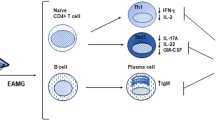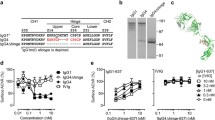Summary
To investigate the underlying mechanism of the exacerbation of myasthenia gravis by aminoglycoside antibiotics. C57/BL6 mice were immunized with acetylcholine receptor (AChR). extracted from electric organ of Narcine timilei according to Xu Haopeng’s methods, in complete Fruend’s adjuvant (CFA) to establish experimental autoimmune myasthenia gravis (EAMG). EAMG mice were divided randomly into 5 groups: MG group, NS group and three antibiotics groups. The clinical symptom scores of mice were evaluated on d7 after the last immunization and d14 of antibiotics treatment. Repetitive nerve stimulation (RNS) was performed and the levels of anti-AChR antibody (AChR-Ab) were tested at the same time. The mean clinical symptom grades of gentamycin group (1. 312, 2.067), amikacin group (1.111, 1.889) and etimicin group (1.263, 1.632) were significantly higher than those of MG group (1.000, 1.200) (P<0.05). The positive rates of RNS of three antibiotics groups were 69.23%, 58.82% and 63.16% respectively, which were significantly higher than those of MG group and NS group (40.00%, 40.00%,P<0.05). The AChR-Ab level in serum and the expression of AChR on neuromuscular junction (NMJ) of mice in three antibiotics groups were also higher than those of MG group. Our results indicated that aminoglycoside antibiotics could aggravate the symptom of myasthenia gravis. The exacerbation of myasthenia gravis by these antibiotics probably involves competitively restraining the release of acetylcholine from presynaptic membrane, impairing the depolarization of postsynaptic membrane, depressing the irritability of myocyte membrane around the end-plate membrane and consequently leading to the blockade of neuromuscular junction.
Similar content being viewed by others
References
Xu L, Villain M, Galin F Set al. Prevention and reversal of experimental autoimmune myasthenia gravis by a monoclonal antibody against acetylcholine receptor-specific T cells. Cell Immunol, 2001, 208(2):107
Cadisch R, Streit E, Hartmann K. Exacerbation of pseudoparalytic myasthenia gravis following azithromycin (Zithromax). Schweiz Med Wochenschr, 1996, 126 (8):308
Vial T, Chauplannaz G, Brunel Pet al. Exacerbation of myasthenia gravis by pefloxacin. Rev neurol (Paris), 1995, 151(4):286
Wang Y F, Sun S G, Cao X Bet al. Study on animal model of experimental autoimmune myasthenia gravis in rats. Chinese Journal of Neuroimmunology and Neurology, 2003, 10(4):242
Lennon V A. Experimental autoimmune myasthenia: A model of myasthenia gravis in rats and guinea pigs. J Exp Med, 1975, 141:1365
Yang M S, Ruan X Z, Huang Y Z. Myasthenia gravis and antibiotics. Chinese Journal of Nervous and Mental Disease, 1984, 10(1):12.
Argov Z, Mastaglia F L. Disorders of neuromuscular transmission caused by drugs. N Engl J Med, 1979, 301:409
Howard J F. Adverse drug effects on neuromuscular transmission. Semin Neurol, 1990, 10(1):89
Ding L. Interaction of aminoglycoside antibiotics and lithium on neuromuscular junction. World Notes on Antibiotics, 1994, 15(5):365
Christadoss P, Poussin M, Deng C. Animal models of myasthenia gravis. Clin Immunol, 2000, 94(2):75
Author information
Authors and Affiliations
Additional information
LIU Changqin, female, born in 1956, Professor
Rights and permissions
About this article
Cite this article
Changqin, L., Fang, H. Investigation on the mechanism of exacerbation of myasthenia gravis by aminoglycoside antibiotics in mouse model. Current Medical Science 25, 294–296 (2005). https://doi.org/10.1007/BF02828147
Received:
Published:
Issue Date:
DOI: https://doi.org/10.1007/BF02828147




